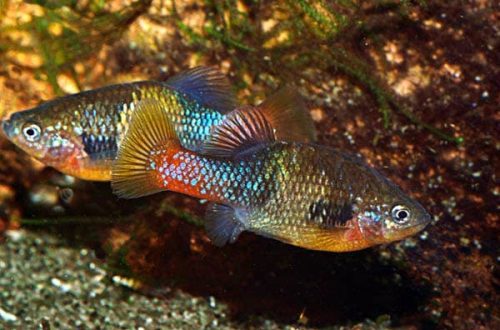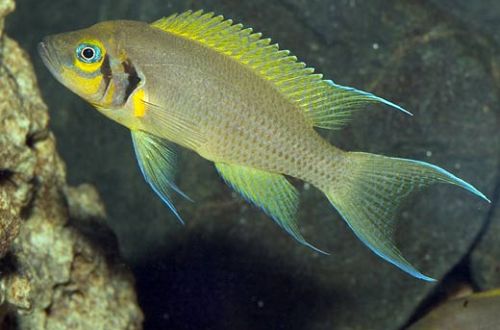
Pecilobrycon striped
The striped pecilobrycon, scientific name Nannostomus espei, belongs to the Lebiasinidae family. A relatively popular aquarium fish, its wide distribution in the hobby aquarium limits the difficulty of breeding. Otherwise, it is peaceful, accommodating and does not cause great difficulties in its content.
Contents
Habitat
It comes from South America, being an endemic species for the Mazaruni River basin in Guyana. Inhabits shallow tributaries, swampy areas of the river, floodplain lakes. Prefers regions with dense coastal aquatic vegetation and numerous shelters in the form of submerged snags and tree roots. The typical habitat is a body of stagnant water saturated with dissolved tannins formed as a result of the decomposition of plant organic matter. Because of this, the water acquires a rich brown color.
Brief information:
- The volume of the aquarium – from 40 liters.
- Temperature – 22-28°C
- Value pH — 4.0–6.5
- Water hardness – soft (1-9 dGH)
- Substrate type – any dark
- Lighting – subdued
- Brackish water – no
- Water movement – little or no
- The size of the fish is up to 3 cm.
- Meals – any
- Temperament – peaceful
- Keeping a flock of at least 10 individuals
Description
Adult individuals reach a length of 2–3 cm. Sexual dimorphism is weakly expressed, males and females are practically indistinguishable. The coloration is light gray with five large dark oval spots. Fins and tail are translucent.
Food
Accepts all types of food of suitable size, intended for aquarium fish. The daily diet can consist either exclusively of dry foods (flakes, granules), or with the inclusion of live or frozen brine shrimp, daphnia, etc.
Maintenance and care, arrangement of the aquarium
The optimal size of the aquarium for a flock of 10 fish starts from 40-50 liters. It is desirable that the design resembles a natural habitat: dim lighting, many aquatic plants, including floating ones, driftwood, dark soil.
An additional design element will be the leaves of some trees. When decomposed, they will release tannins, giving the water a chemical composition similar to that in which fish live in nature.
Successful long-term management of Pecilobricons striata depends on maintaining stable water conditions within an acceptable range of hydrochemical values and temperatures. To achieve this goal, it is necessary to equip the aquarium with all the necessary equipment and carry out regular maintenance (water changes, cleaning of organic waste and plaque, etc.).
It is worth considering carefully the choice of a filtration system. Fish, being native to stagnant water bodies, are sensitive to water movement, and the filter is the main source of flow in the aquarium. In some cases, a simple airlift filter with a sponge is quite suitable for a small tank.
Behavior and Compatibility
A peaceful, active fish, but due to its timid disposition and small size, it can only be in the company of similar species. Although the fish stay in a group, they can hardly be called a flock, since intraspecific relationships are built on competition between males, but it doesn’t come to skirmishes. It is recommended to maintain a population of at least 10 individuals; with a smaller number, Pecilobrycons will become unnecessarily shy.
Breeding / breeding
Breeding in a home aquarium is possible, but involves some difficulties and may be beyond the power of a novice aquarist. In the artificial environment, the breeding season is not expressed. Fish do not come into spawning at the same time. Situations are not rare when some of the females are filled with caviar, while others are not, while the males take care of everyone. It is worth noting that females are very picky in choosing a partner and not every male will be able to interest them. A large group is needed to guarantee the formation of a temporary pair. When a pair is formed, the female lays eggs on the underside of broad-leaved plants, such as Anubias or Echinodorus, and the male fertilizes her. From that moment on, their short-term relationship ends.
Parental instincts are not developed, adult fish tend to eat their own caviar and fry. The brood can be saved by transferring the clutched plant to separate tanks with identical water conditions. The incubation period lasts 1-2 days, after another week the fry begin to swim freely in search of food. Feed such tiny ones with specialized powdered feed, suspensions or infusoria shoes, if available.
Fish diseases
Health problems arise only in case of injuries or when kept in unsuitable conditions, which depresses the immune system and, as a result, provokes the occurrence of any disease. In the event of the appearance of the first symptoms, first of all, it is necessary to check the water for the excess of certain indicators or the presence of dangerous concentrations of toxic substances (nitrites, nitrates, ammonium, etc.). If deviations are found, bring all values back to normal and only then proceed with treatment. Read more about symptoms and treatments in the Aquarium Fish Diseases section.





